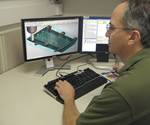Published
CAM Developer CEO Forecasts R&D Cash Crunch
Dan Frayssinet, CEO of Esprit CAM software developer DP Technology, predicts tough times ahead for CAM developers.
Dan Frayssinet, CEO of Esprit CAM software developer DP Technology, predicts tough times ahead for CAM developers. Due to the nature of the industry, the accelerating pace of technological development and what has been dubbed “The Great Recession,” many CAM companies might soon find themselves struggling to keep their software up-to-date with the latest manufacturing technology developments, he says.
The root of the problem is that CAM software lies at the intersection of many disciplines. When a new type of machine is unveiled, software capabilities must be updated to support it. Simultaneously, however, the software must maintain compatibility with various, constantly evolving CAD standards, new cutting tool designs, new exotic materials, and new manufacturing processes, all of which seem to change daily. Add to that new operating systems and other general computing developments such as parallel computing, or multi-threading—the benefits of which are attainable only by rewriting large portions of code. (The three articles under “Editor’s Picks” at the upper right corner of this page provide examples of some of these developments and what CAM companies are up against. One discusses parallel computing and another provides an overview of 64-bit computing, both of which are used in Esprit. The third details post processors, one of the most important elements in any CAM system.)
Keeping up with all this requires a significant investment in R&D. Problem is, the needs in this area far outclass the revenue that can be gained from the market share of any one CAM company, Mr. Frayssinet says. Despite the presence of more than 100 CAM developers, the industry as a whole is relatively small, amounting to about $1 billion. The average developer is worth around $10 million and typically devotes anywhere between 15 to 20 percent of its budget toward R&D—not nearly enough to keep pace with innovations in all the fields that feed CAM software evolution. The problem is compounded by the ongoing recession, which has slashed revenues at a time when new development is sorely needed.
As a result, the CAM industry could reach a crisis point in coming years, Mr. Frayssinet says. In response, DP Technology’s strategy is to rely more on its customers and partners to help incorporate new knowledge and functionality into the software. One example is an agreement with DMG/Mori Seiki, through which all Mori machines incorporating the builder’s MAPPS operating system ship with a preinstalled seat of Esprit.
Enlisting Mori’s help in developing machine-specific post-processors not only alleviates some of the DP Technology’s R&D burden, but also benefits the builder and both companies’ customers, who receive fully certified posts with their machines. In an age when a development in one area can significantly impact another, going straight to the source for needed expertise might just help the CAM developers caught in the middle stay at the leading edge, despite limited resources.












.png;maxWidth=300;quality=90)
